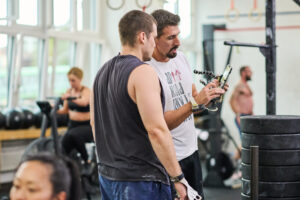
What really changes after 40?
Not much—at least not the fundamentals.
A human body is still a human body. Strength is still built with resistance training. Conditioning still improves with consistent effort. The basic rules of movement, recovery, and adaptation don’t suddenly stop working when you hit 40. Muscles don’t know your age—they respond to what you do with them.
What does change, however, is how much room for error you have.
In your twenties, you could skip sleep, eat haphazardly, train hard without a plan, and still make progress. Your body was resilient and forgiving. That margin for error starts to shrink in your thirties and becomes much smaller in your forties. Your recovery slows, your hormonal profile shifts, and the physical stress from training interacts more directly with the stress of life outside the gym.
But none of this means progress is over—it simply means your approach needs to evolve. The goal isn’t to slow down. It’s to train with purpose. It’s to stay strong, capable, and resilient—not just for today, but for the decades ahead.
Here’s what that looks like in practice.
What changes after 40
Recovery becomes essential
At this stage, recovery isn’t something you hope happens on its own—it becomes something you must actively manage. Poor sleep, high stress, and inconsistent nutrition hit harder and take longer to recover from. Where you may have once bounced back from a heavy squat session or high-volume workout overnight, now you might need two days, especially without proper recovery habits in place.
You need to think about sleep quality, post-workout nutrition, hydration, mobility work, and stress management as part of your training—not separate from it.
Muscle mass and power decline faster—unless you train to stop it
After the age of 30, you begin to lose muscle mass at a rate of 3 to 8 percent per decade. Power—your ability to produce force quickly—is the first quality to decline. This is one of the reasons we see so many people become slower, more fragile, and less coordinated as they age.
The good news? These losses can be dramatically slowed, or even reversed, through focused strength and power training. This includes not only traditional lifts like squats and deadlifts, but also explosive work such as kettlebell swings, sled pushes, or jump variations—appropriately scaled, of course.
Joint health and mobility matter more
Tight shoulders, stiff hips, and achy knees don’t just happen. They’re the result of disuse, poor movement habits, and low daily activity—not simply age. Joint health is maintained through movement. You don’t need to be ultra-flexible, but you do need full range of motion in the joints you use most.
After 40, maintaining functional mobility isn’t optional—it’s the foundation of injury prevention and long-term performance.
Life load is heavier
In your twenties, your biggest concern might have been choosing a time to train. In your forties, you’re juggling a career, children, aging parents, financial stress, and more. Energy is finite. This doesn’t mean training becomes less important—it becomes more important, but it must be efficient, intentional, and realistic.
The idea isn’t to cram in more. It’s to train smarter with the time and energy you do have.
What doesn’t change
Your body still responds to smart training
Age is not a barrier to strength, muscle, or fitness. In fact, many people in their 40s and 50s reach higher levels of fitness than they ever had in their twenties—because they finally train with consistency and purpose.
Your physiology still adapts. It still improves with effort. The difference now is that the plan must be better, and the margin for error is smaller. But make no mistake: real, measurable progress is absolutely still on the table.
Intensity still matters
Training without intensity is just movement. Movement is good, but it doesn’t drive change the way structured, progressive, and intentional intensity does.
That doesn’t mean going “all out” every session. It means knowing when to push, how much to push, and when to pull back. Structured variation, guided by a coach or a well-designed program, keeps your training sustainable and effective.
Community is still a superpower
Training alone is hard. Staying consistent over years—decades—is even harder. Surrounding yourself with others who understand your goals, challenges, and mindset creates a powerful environment for long-term success.
The social side of training doesn’t just provide accountability. It improves enjoyment, increases effort, and adds a layer of support that becomes even more valuable as life gets more complicated.
Final thoughts
So what changes after 40? Turning 40 doesn’t mean slowing down. It means leveling up your strategy.
You don’t need to train like you did in your twenties. You need to train like someone who wants to feel strong, capable, and confident in their body for decades to come.
The basics haven’t changed: lift heavy, move with intensity, sleep well, eat enough real food, and recover like it matters. But your approach must change. You can’t skip the hard conversations with your body anymore. You need a plan that’s realistic, personalized, and rooted in long-term success—not short-term intensity followed by injury or burnout.
And if you’ve never had a plan before? There’s no better time to start than now.
At CrossFit Kreis 9, we coach a wide range of people—but our largest group consists of parents and busy professionals in their 40s and beyond. These are people with full lives, limited time, and the understanding that they no longer have the wiggle room they did in their twenties. They want effective, time-efficient, and purposeful training—and that’s exactly what we deliver.
We combine smart programming with personalized coaching in a community that understands your life and goals.
No judgment. Just results.




